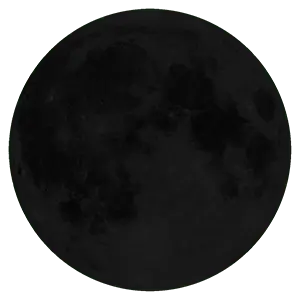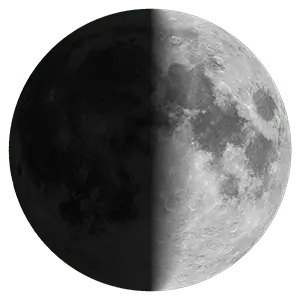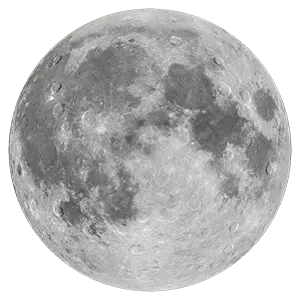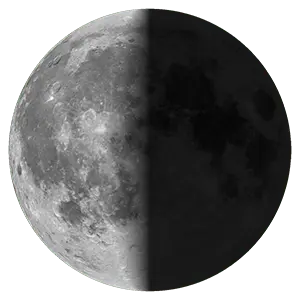The current moon phase for today and tonight is the phase. The moon is now % visible and is . Today the Moon is days old.
The approximate distance from Earth to the Moon is and days left to the next phase ().
Visit also the December 2025 Moon Phase Calendar to see all the daily moon phases for this month.
Current Time: 11.15.
Moon Phase Today:
Previous Phase:
Moon distance:
Illumination:
Moon age:
Next Phase:
Moon angle:
Sun distance:
| Moon Phase | DATE AND TIME |
DATE AND TIME (UTC) |
|---|---|---|
| New Moon | ||
| First Quarter | ||
| Full Moon | ||
| Last Quarter | ||
| New Moon |

This is the first and invisible phase of the Moon, with the illuminated side of the Moon facing the Sun and the night side facing Earth. The New Moon is only directly visible during a solar eclipse.

First Quarter
A week after new moon comes first quarter, when the Moon is a quarter of the way around its orbit. It is also termed a Half Moon. A First Quarter Moon rises around noon and sets around midnight.

Full Moon
At 100% phase illumination, the day side of the Moon is directly pointed at the night side of the Earth and the Moon is full. A Full Moon rises around sunset and sets around sunrise and it looks bigger when it is near the horizon.

Last Quarter
The Moon enters the Last Quarter (or Third Quarter) of its orbit at nearly 23 days old. Only half of it appears to be illuminated. You can see this phase at late night and in the early morning (6 am).
A "micromoon" is a term used in popular astronomy to describe a full moon or a new moon that occurs when the moon is at or near its apogee, which is the furthest point from Earth in its elliptical orbit. This is the opposite of a "supermoon," which occurs when a full moon or new moon is at or near its perigee, which is the closest point to Earth in its orbit."
More Moon FactsThe Moon makes Earth a more livable planet by moderating our home planet's wobble on its axis, leading to a relatively stable climate.
More Moon FactsThe Moon crust is made of composed primarily of oxygen (O), silicon (Si), magnesium (Mg), iron (Fe), calcium (Ca), and aluminum (Al), but important minor and trace elements such as titanium (Ti), uranium (U), thorium (Th), potassium (K), and hydrogen (H) are present as well. Below the crust is the mantle coming, with a thickness of roughly 1350 km is far more extensive than the crust, which has an average thickness of about 50 km. The mantle is made of olivine, orthopyroxene and clino pyroxene. Finally, at the center is the Moon’s dense, metallic core. The core is largely composed of iron (Fe) and some nickel (Ni). The inner core is a solid mass of about 480 km in diameter. Surrounding the solid inner core is a fluid outer core, that brings the total diameter of the core to about 660 km.
More Moon FactsThis is an optical illusion. The Moon looks large shortly after it rises when it's still touching the horizon. This is not the same as a Supermoon.
More Moon FactsThe Moon is the fifth largest satellite in the Solar System and the biggest in comparison to its host planet, with a diameter about one-quarter that of Earth. The exact diameter is 2159.14 miles (3 474.8 km ).
More Moon FactsThere are four major lunar phases: the New Moon, the First Quarter, the Full Moon, and the Last Quarter (also known as the Third or Final Quarter). There are also four minor phases: waxing crescent, waxing gibbous, waning gibbous, and waning crescent.
More Moon PhasesThe Full Moon is the fifth lunar phase. The Moon appears fully illuminated from Earth's perspective. This occurs when Earth is located between the Sun and the Moon. A Full Moon rises around sunset and sets around sunrise.
More Moon PhasesThis is the fourth phase of the Moon. The waxing gibbous phase is between a Half Moon and Full Moon and waxing means that the Moon is getting bigger and bigger. This phase of the Moon can be seen from late afternoon and most of the night (from 3 pm to 3 am).
More Moon PhasesThe 8 moon phases in order are new moon, waxing crescent, first quarter, waxing gibbous, full moon, waning gibbous, last quarter, and waning crescent. The Moon displays these eight phases one after the other as it moves through its cycle each month. It takes 27 days for the Moon to orbit Earth. That means the Moon's cycle is 27 days long.
More Moon PhasesThis is the eighth and also the final phase of the Moon. The Moon is nearly back to the point in its orbit where its dayside directly faces the Sun, and all that we see from our perspective is a thin curve. The Wanning Crescent Moon can be seen from pre-dawn to early afternoon.
More Moon PhasesMoon dust smells like gunpowder. Just to be clear, moondust and gunpowder are not the same thing, so why is this gunpowder smell? No one really knows.
More Fun FactsNo one. According to international law, no one can lay territorial claim to the Moon or any other celestial body, so a national flag on the Moon is purely symbolic. There are also websites where you can buy a certificate saying you own a plot of land on the Moon, but this isn't worth the paper it is written on.
More Fun FactsBelievers in the lunar cycle effects on human bodies (including the hair) ascribe a similarly forceful effect of this gravitational field on the bodies of humans and animals. According to their belief system, hair grows stronger, hair care products work better, and the styling is more beautiful if the hair care regimen is scheduled according to the lunar calendar. Conditions during the waxing moon promote hair growth after a haircut. Therefore, you should cut your hair between the new and full moon if you want your hair to grow fast after a haircut.
More Fun FactsA lunar eclipse occurs when the Moon moves into the Earth's shadow. This can occur only when the Sun, Earth, and Moon are exactly or very closely aligned with Earth between the other two, which can happen only on the night of a Full Moon. A total lunar eclipse occurs when the Moon falls entirely within the Earth's umbra.
More Fun FactsIn many languages the Moon is gender neutral, in other languages it’s not. For example, in French, the Moon is feminine (la lune) and in German, the Moon is masculine (der Mond). From a cultural point of view, the Moon is often referred as feminine. For example, in Greek mythology, Selene was the Goddess of the Moon and so the Moon has been known as Selene. In Roman mythology, it was the Goddess Luna, from where we get Lunar cycles from. This would give the moon a female gender.
More Fun Facts